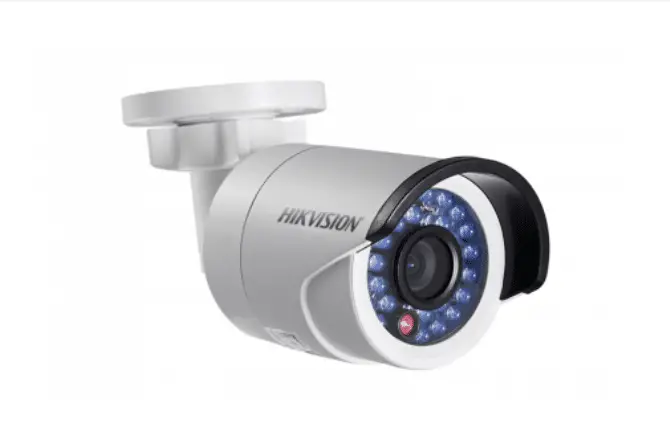Are home security cameras worth it? I definitely think they are. You might think that a home security camera system is expensive but if you build a DIY system without a monthly fee then it’s fairly inexpensive. Having an outdoor camera does deter burglars and it has other benefits as well. For example, you can see who is at the door and check did your child come home from school already.
Different types of security cameras
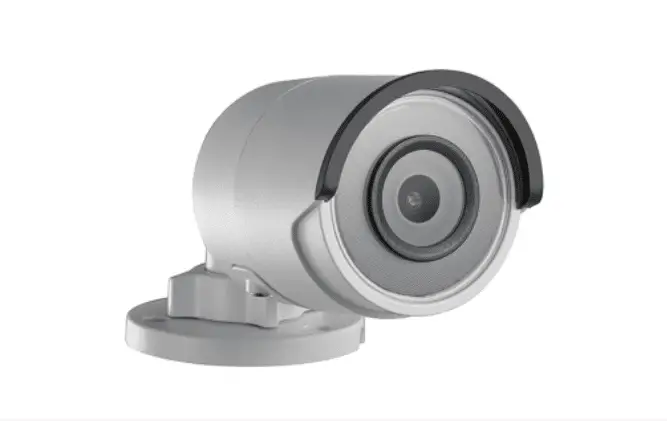
Mini Bullet camera 
Dome camera 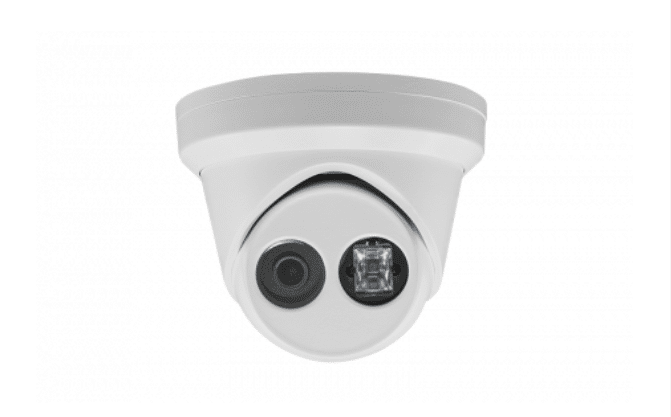
Turret camera 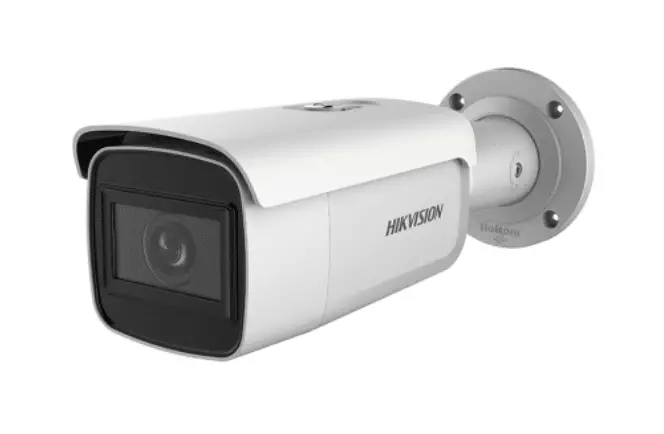
Varifocal Bullet camera 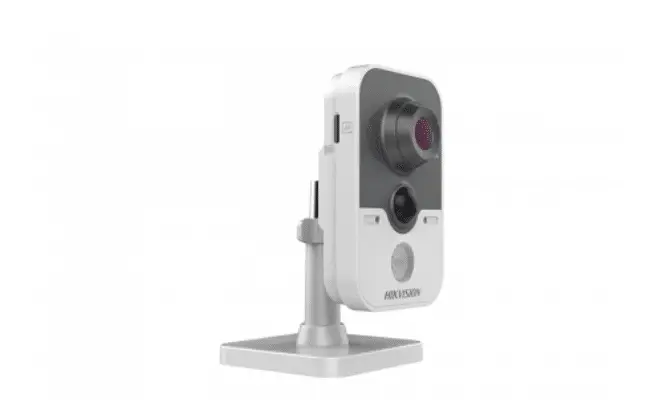
Indoor Cube camera
What are the different types of security cameras? There are multiple ways of listing types of cameras. One is based on what cables it needs: Wired, Wireless, and Wire-free. The second is based on weatherproofing: Outdoor and Indoor cameras. The third is based on lenses: Fixed focal length and Varifocal cameras. A fourth is based on style: Dome, Bullet, Turret. A fifth is based on functionality like PTZ (Pan, Tilt, and Zoom), Voice integrated, Infrared cameras, etc.
Many camera manufacturers still list their cameras as network cameras or IP cameras meaning that they are digital cameras that communicate via the Internet Protocol. Some manufacturers also still have analog cameras. Since the IP camera prices have come down it’s the only form of camera I would consider.
For the purpose of this article I will mainly focus on the wired outdoor cameras.
Wired, Wireless and Wire-free cameras
Wired IP cameras are the de facto standard cameras most often used. They usually have a POE (Power over Ethernet) connector meaning that they can get power over the same cable which they send the signal on.
Wireless for a camera usually doesn’t mean wire-free but instead it just means that it can use a wifi connection to send the signal but the camera still requires a power cable.
Wire-free cameras don’t need any cables so they usually use wifi to send the signal and have batteries to power them.
Considering the different options it makes a lot of sense that for permanent installations most people choose the wired IP cameras.
If the camera is battery powered it’s quite bothersome to change the battery or charge it from time to time and it’s not really worry-free considering the battery might run out when you most need the camera.
The wireless option with wifi still needs the power cable so it’s not really saving you any cabling since the wired camera only needs one cable as well. Also, wifi signals can be interfered with and are not as reliable.
Outdoor and Indoor cameras
Outdoor cameras are weatherproof and usually have an IP66 rating and are designed to withstand extreme temperatures and they are protected against dust and rain.
Outdoor cameras are typically in bullet, dome or turret form. Some of the outdoor cameras have microphones so that you can also hear what’s happening.
Indoor cameras are not weatherproof and come in many shapes and sizes. It’s more common to find microphones and speakers on indoor cameras that allow for two way communication. Outdoor cameras are commonly used for indoor installations as well.
Fixed focal length and Varifocal Cameras
Fixed focal length IP cameras have a fixed focal length lens which you need to choose upon purchase. The focal length determines the field of view and you can’t zoom except for digital zooming. The options for example for Hikvision IP cameras are 2.8mm, 4mm, and 6mm lenses.
Varifocal cameras have a motorized zoom lens which allows you to optically zoom and adjust the field of view. This is very handy for the time of installation if you want to focus on a specific target, for example, a doorway. For example, the Hikvision varifocal IP cameras often have a 2.8mm to 12mm varifocal lens.
The price difference between an outdoor fixed focal length camera and a varifocal camera can be quite significant. Often you can get two fixed focal length cameras for the price of one varifocal camera. Compare for example 110$ for a 4MP mini bullet IP camera and 220$ for a 4MP varifocal bullet IP camera from Hikvision.
Camera functionality

IR PTZ camera 
IR Dome camera
IR or infrared functionality is very common on security cameras and even the cheaper cameras usually have infrared led lights illuminating up to 100 ft or 30 meters. In my experience, though it’s hard to see clearly beyond 5 or 8 meters. The IR functionality essentially gives you night vision with the ability to see people and objects even in pitch-black darkness.
PTZ or Pan, Tilt, and Zoom cameras have a motor so that they can be remotely operated and panned left to right and tilted up and down. PTZ cameras are essentially dome cameras, but they are larger in size due to the motor being housed in the base of the unit. Often these cameras also have a varifocal lens allowing to zoom.
The main advantage of a PTZ camera is its flexibility allowing for 360-degree views. But this is usually beneficial only in real-time use when you can turn the camera to where the action is. From a recording standpoint, it doesn’t help that your camera could have covered an event but it was pointed in the wrong direction.
PTZ cameras can cost around double compared to an ordinary dome camera. For example, a Hikvision 4MP PTZ camera can be around 210$ and a Hikvision 4MP dome camera can be around 110$.
Two way audio with a built-in microphone and speaker do exist on some surveillance cameras. However, the name brands manufacturing traditional surveillance cameras like Hikvision and Dahua have very few two-way audio cameras. Hikvisions cube camera has two-way audio, but it’s an indoor camera. Some Dahua outdoor turret cameras have a built-in microphone at a very affordable price.
Camera Brands
There are a huge number of network camera manufacturers but for inexpensive home use, the two quality brands to consider are Hikvision and Dahua. These two companies are also OEMs or original equipment manufacturers that produce equipment that can be sold by other companies under their brand names.
Since Hikvision and Dahua have such a large chunk of the market share especially for the inexpensive cameras, the main focus in this article are on camera examples from these two manufacturers.
Hikvision
Hikvision was established in 2001 in China and currently, they have more than 18 000 employees. Hikvision is the worlds leading video surveillance products manufacturer with around 20 percent market share.
There are over 70 companies that use Hikvision as an OEM for some of their products like Annke, Hitachi, Hyundai, Sharp, Syscom, Trendnet, and Toshiba. For a more complete list of Hikvision OEMs you can check the IPVM OEM directory.
Dahua
Dahua was established in 2001 in China and currently, they have more than 16 000 employees. Dahua is one of the worlds leading video surveillance products manufacturers and is in second place with a market share of around 6 percent according to reports from a few years ago.
There are over 40 companies that use Dahua as an OEM for some of their products like Lorex, Honeywell, Bosch, and Panasonic. For a more complete list of Dahua OEMs you can check the IPVM OEM directory.
Lorex is a Canadian operated company that manufactures and distributes security cameras mainly in North America. In 2018 Lorex was acquired by Dahua.
Axis Communications
Axis Communications is a Swedish manufacturer of network cameras founded in 1984 with more than 3000 employees currently.
Outdoor cameras for Home Use
Personally I bought my first network camera in 2015 and it was a Hikvision DS-2CD2032-I 3MP bullet camera with IR functionality. I installed the camera myself and it has been operating non-stop ever since. It has survived the cold winters and hot summers without any issues.
It’s a POE powered camera so you do need a POE device for it. For example, the TP-LINK TL-SG1008P 8 Port Gigabit Unmanaged Desktop Switch with 4-Port PoE is a very inexpensive product that I have often used in camera installations. I bought my TP-LINK POE for under 50€.
General notes when buying a security camera
Some of the cameras that are sold in the US and in Europe and elsewhere in the world are Chines market cameras with hacked firmware to provide English language menus. You can use those cameras, but often the seller indicates that you shouldn’t update the camera firmware and you can’t find the camera on the Dahua or Hikvision US website. They are cheaper but one of the disadvantages is that you can’t get new camera features in future firmware updates.
Bullet Cameras
Network bullet security cameras are one of the easiest to start with since the mini bullet cameras are very inexpensive and easy to install. One feature of the bullet cameras is that you can easily point them still after screwing them to the roof or wall.
A downside of the bullet cameras is that they are not vandal resistant and therefore they are seldom used in commercial settings outdoors. For home use I think it’s fine in most neighborhoods.
I haven’t either come across bullet cameras with built-in microphones.
| Picture | Buy on Amazon | Price | Rating | IP rating | Sensor | IR distance | Lens | Focal Length | Buil-in Mic | MicroSD slot | Power | Firmware updates | Type | Released | Brand |
|---|---|---|---|---|---|---|---|---|---|---|---|---|---|---|---|
 | Dahua IPC-HFW4431R-Z | under $100 | 5 | IP67 | 4MP | 60m | Varifocal | 2.8-12mm zoom | No | PoE 802.3af | No | Bullet | Dahua | ||
 | Hikvision DS-2CD2043G0-I | under $100 | 3.8 | IP67 | 4MP | 30m | Fixed | 2.8, 4.0mm | No | Up to 128GB | PoE 802.3af | Yes | Bullet | 2018 | Hikvision |
 | Dahua N41BD22 | under $150 | - | IP67 | 4MP | 30m | Fixed | 2.8mm | No | - | PoE 802.3af | Yes | Bullet | 2018 | Dahua |
Turret Cameras
Turret cameras have a shape similar to dome cameras but without the vandal-resistant dome. They are easy to point after the installation and I consider them a great option for starting out. Many turret cameras also have built-in microphones.
| Picture | Buy on Amazon | Price | Rating | IP rating | Sensor | IR distance | Lens | Focal Length | Buil-in Mic | MicroSD slot | Power | Firmware updates | Type | Released | Brand |
|---|---|---|---|---|---|---|---|---|---|---|---|---|---|---|---|
 | Dahua IPC-HDW4631C-A | under $100 | 3.7 | IP67 | 6MP | 50m | Fixed | 2.8mm | Yes | PoE 802.3af | No | Turret | 2017 | Dahua | |
 | Dahua IPC-HDW4433C-A | under $100 | 4.1 | IP67 | 4MP | 50m | Fixed | 2.8mm | Yes | PoE 802.3af | No | Turret | Dahua | ||
 | Hikvision DS-2CD2345FWD-I | under $100 | 4.1 | IP67 | 4MP | 30m | Fixed | 2.8, 4.0, 6.0mm | No | Up to 128GB | PoE 802.3af | Yes | Turret | 2018 | Hikvision |
 | Dahua N44CG52 | under $150 | - | IP67 | 4MP | 50m | Fixed | 2.8, 3.6mm | Yes | Up to 128GB | PoE 802.3af | Yes | Turret | 2019 | Dahua |
Dome Cameras
Network dome security cameras are vandal resistant due to the dome protecting the camera and the way it is installed without any cables visible. However, it’s harder to point the camera in the correct direction since you can’t easily turn it anymore after finalizing the installation.
Nowadays even some dome cameras have built-in microphones.
| Picture | Buy on Amazon | Price | Rating | IP rating | Sensor | IR distance | Lens | Focal Length | Buil-in Mic | MicroSD slot | Power | Firmware updates | Type | Released | Brand |
|---|---|---|---|---|---|---|---|---|---|---|---|---|---|---|---|
 | Dahua IPC-HDBW4631R-S | under $100 | 4.2 | IP67 | 6MP | 30m | Fixed | 2.8mm | No | PoE 802.3af | No | Dome | Dahua | ||
 | Hikvision DS-2CD2143G0-I | under $100 | 5 | IP67 | 4MP | 30m | Fixed | 2.8, 4.0mm | No | Up to 128GB | PoE 802.3af | Yes | Dome | 2018 | Hikvision |
 | Hikvision DS-2CD2143G0-IU | under $150 | - | IP66 | 4MP | 30m | Fixed | 2.8, 4.0, 6.0mm | Yes | Up to 128GB | PoE 802.3af | Yes | Dome | 2019 | Hikvision |
 | Dahua N44CL52 | under $150 | - | IP67 | 4MP | 30m | Fixed | 2.8, 3.6mm | No | Up to 128GB | PoE 802.3af | Yes | Dome | 2019 | Dahua |
Wiring considerations
It’s a good idea when building a new house to consider CAT6 wiring for security cameras and to pull an extra cable to locations where devices are planned since you might end up putting for example two cameras instead of one.
Also leave extra slack on cables so that one can adjust the intended camera location later on if necessary.
If you neglected adding extra cables you can still use for example a POE extender to add more cameras. You can order this 4 port POE extender from Aliexpress.


